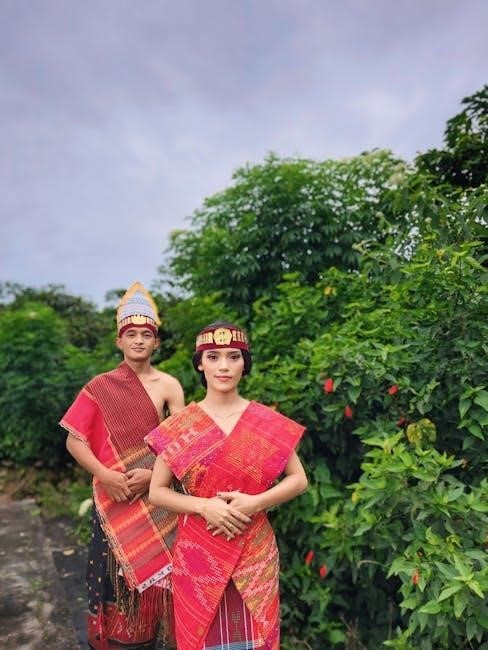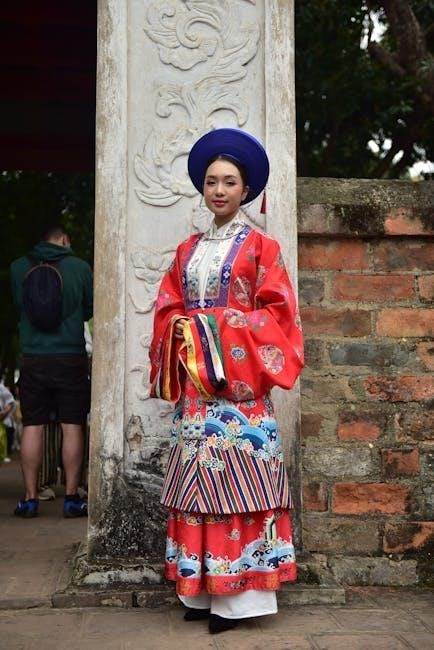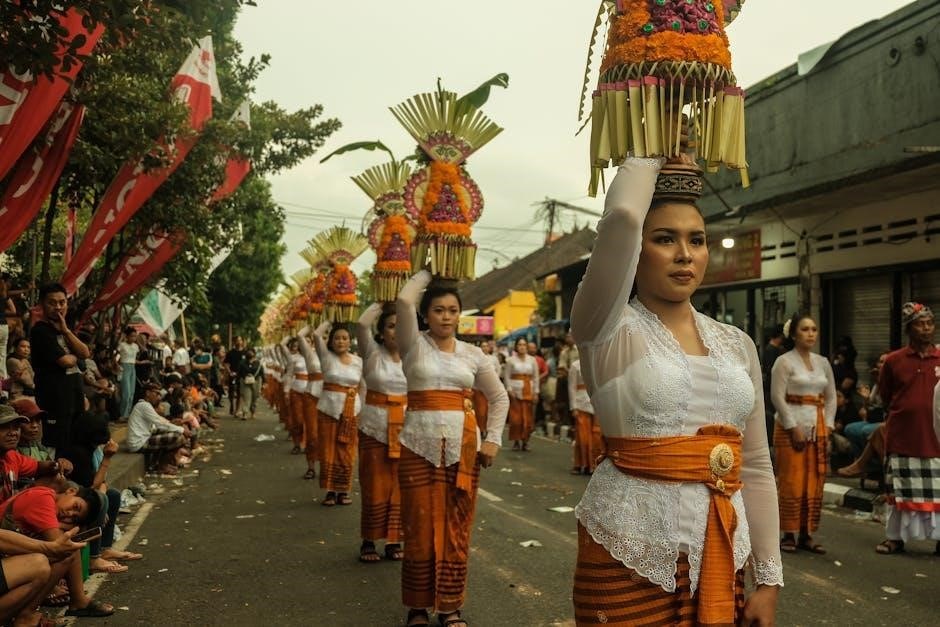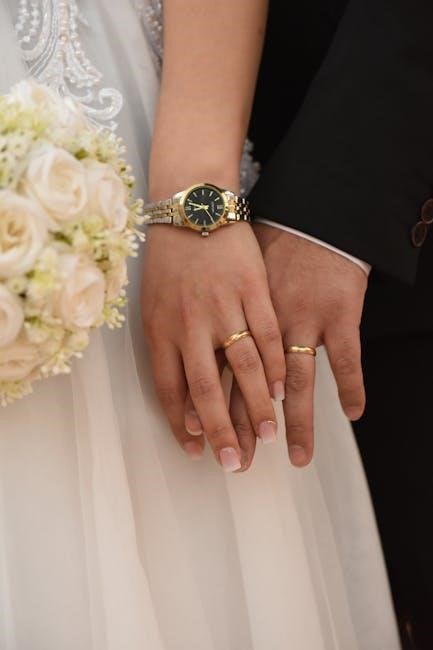Ceremony by Leslie Marmon Silko is a profound novel published in 1977, exploring healing and cultural identity through its protagonist’s journey, significantly impacting Native American literature and culture․
Overview of “Ceremony”
Ceremony is a novel by Leslie Marmon Silko, published in 1977․ It tells the story of Tayo, a Laguna Pueblo veteran haunted by World War II, as he seeks healing through traditional rituals․ Blending myth, history, and personal narrative, the novel explores themes of trauma, identity, and cultural resilience․ The “ceremony” itself becomes a symbol of spiritual renewal and restoration; Silko’s work is celebrated for its vivid storytelling and its deep connection to Native American traditions and struggles․
Historical and Cultural Context
Ceremony is set on the Laguna Pueblo Reservation after World War II, reflecting the cultural and historical challenges faced by Native Americans․ It examines the clash between traditional Pueblo beliefs and modernity, as well as the intergenerational trauma resulting from colonialism and war․ Silko draws heavily from Laguna oral traditions, emphasizing the importance of storytelling in preserving cultural identity․ The novel highlights the resilience of indigenous communities and their spiritual practices as a means of healing and survival․
Author Background
Leslie Marmon Silko, born in 1948 to a family of Laguna Pueblo, Mexican, and European heritage, grew up on the Laguna Reservation, deeply influenced by its stories and traditions․
Leslie Marmon Silko’s Ancestry and Influences
Leslie Marmon Silko’s rich ancestry includes Laguna Pueblo, Mexican, and European roots, shaping her cultural identity․ Raised on the Laguna Reservation, she immersed herself in its stories, traditions, and oral histories, which deeply influenced her writing․ Her work reflects the blending of these cultural threads, creating a unique narrative voice that honors her heritage while addressing broader themes of identity and resilience․

Significance of Laguna Pueblo Heritage
Laguna Pueblo heritage is central to Ceremony, providing cultural and spiritual frameworks․ The novel draws on Pueblo traditions, emphasizing storytelling and ceremonial practices as vital for healing and identity․ Silko’s portrayal of Laguna beliefs and rituals highlights their enduring relevance, offering readers a window into the rich tapestry of Native American culture while underscoring the importance of preserving these traditions in contemporary contexts․
Publication Details

Ceremony was first published in March 1977 by Viking Press, marking a significant milestone in Native American literature with its unique blend of storytelling and cultural depth․
First Edition and Reception
The first edition of Ceremony was published in March 1977 by Viking Press, receiving widespread critical acclaim for its unique storytelling and cultural depth․ Critics praised its exploration of identity, trauma, and healing, recognizing it as a landmark work in Native American literature․ The novel resonated deeply with readers, establishing Silko as a prominent voice in contemporary storytelling․ Its reception highlighted its significance as both a literary achievement and a cultural milestone, solidifying its place in American literary history․
Impact on Native American Literature
Ceremony revolutionized Native American literature by blending traditional storytelling with modern narrative techniques․ It challenged stereotypes and provided an authentic voice to Indigenous experiences, influencing future generations of Native writers․ The novel’s exploration of cultural identity, spirituality, and historical trauma set a new standard for literary representation․ Its success paved the way for diverse narratives, enriching the literary landscape with profound cultural insights and fostering a deeper understanding of Native American perspectives and traditions, both locally and globally․

Themes
Ceremony by Leslie Marmon Silko explores themes of healing through ritual, identity struggles, and the clash between traditional and modern worlds, emphasizing cultural preservation;
Healing and Spirituality
Ceremony by Leslie Marmon Silko emphasizes healing through rituals and storytelling, central to Tayo’s recovery․ The novel highlights the interconnectedness of physical and spiritual well-being, as seen in Betonie’s guidance, blending traditional ceremonies with modern struggles․ Tayo’s journey illustrates how spiritual practices, like the scalp ceremony, restore balance and identity, countering the trauma of war and cultural dislocation․ Silko’s work underscores the enduring power of Native American traditions in fostering resilience and renewal․
Identity and Belonging
Ceremony delves into Tayo’s struggle with identity, reflecting his mixed heritage of Laguna, Mexican, and European roots․ Silko portrays his alienation from both his community and the broader society, exacerbated by war trauma․ Through rituals and storytelling, Tayo reconnects with his Laguna Pueblo heritage, discovering a sense of belonging․ The novel explores how cultural identity is both a source of strength and a site of tension, ultimately portraying identity as fluid yet deeply rooted in tradition and community․
Cultural Preservation
Ceremony underscores the importance of cultural preservation through storytelling and traditional rituals․ Silko highlights how these practices sustain Native American identity and resilience․ The novel emphasizes the role of elders and spiritual leaders like Betonie in passing down cultural knowledge․ By blending myth and reality, Silko ensures the survival of Laguna Pueblo traditions, illustrating how cultural preservation is vital for healing and community cohesion in the face of historical trauma and modern challenges․

Major Characters
Tayo, the protagonist, is a Laguna Pueblo veteran struggling with trauma․ Betonie, a wise spiritual guide, helps Tayo on his healing journey, while other characters like Ts’eh and Captain play pivotal roles․
Tayo: The Protagonist’s Journey
Tayo, a Laguna Pueblo veteran, returns home from World War II, haunted by trauma and cultural dislocation․ His journey is one of spiritual and emotional healing, guided by Betonie, a wise medicine man․ Through ceremonies and storytelling, Tayo confronts his inner turmoil, reconnecting with his heritage and finding solace in ancient traditions․ His path symbolizes the struggle to reconcile modernity with cultural identity, ultimately leading to renewal and self-discovery․
Betonie: The Spiritual Guide
Betonie, a wise and unconventional Navajo medicine man, plays a pivotal role in Tayo’s healing journey․ His knowledge of ancient rituals and ceremonies helps Tayo confront his trauma and find spiritual balance; Betonie’s teachings emphasize the interconnectedness of all life and the power of storytelling, guiding Tayo toward self-discovery and renewal․ Through Betonie, Silko highlights the importance of cultural traditions and spiritual wisdom in the face of modernity and personal anguish․
Structure and Style
Leslie Marmon Silko’s Ceremony employs a non-linear narrative, blending myth and reality to create a rich, layered story that enhances its themes of healing and identity․
Non-Linear Narrative
Ceremony features a non-linear narrative, weaving together past and present, myth, and reality․ Silko’s structure mirrors Tayo’s fragmented state of mind, gradually revealing his journey through World War II trauma and cultural dislocation․ The interplay of timelines underscores the novel’s themes of healing and identity, allowing Silko to blend traditional Laguna stories with contemporary struggles․ This narrative style creates a layered, immersive experience, reflecting the cyclical nature of Indigenous storytelling and the protagonist’s path toward spiritual renewal․
Blending of Myth and Reality
Ceremony masterfully intertwines traditional Laguna myths with Tayo’s real-life experiences․ Silko uses mythic narratives to explain natural phenomena and human struggles, while grounding them in Tayo’s post-war trauma․ This blend creates a holistic view of reality, where the spiritual and physical worlds coexist․ The novel’s structure allows Silko to explore universal truths through cultural specificity, making the story both deeply personal and broadly relatable․ This fusion enriches the narrative, offering readers a unique perspective on healing and identity․

Cultural Significance
Ceremony holds profound cultural significance as a landmark in Native American literature, offering a powerful exploration of identity, trauma, and healing while preserving Indigenous traditions and voices․
Representation of Native American Voices
Ceremony by Leslie Marmon Silko is a groundbreaking work that amplifies Native American voices, challenging stereotypes and fostering understanding․ Silko masterfully blends traditional stories with modern narrative, offering a poignant portrayal of Indigenous identity and resilience․ The novel provides a platform for marginalized voices, celebrating cultural heritage while addressing historical trauma․ Through its vivid storytelling, Ceremony validates Indigenous experiences, making it a vital contribution to Native American literature and a powerful tool for cultural preservation and dialogue․
Exploration of Trauma and Recovery
Ceremony delves into the profound trauma experienced by Tayo, a Laguna Pueblo veteran, as he grapples with the horrors of World War II and cultural displacement․ Silko masterfully weaves together traditional ceremonies and personal narratives to illustrate the healing process․ The novel highlights how ancient rituals and storytelling serve as tools for recovery, addressing both individual and intergenerational trauma․ Through Tayo’s journey, Silko underscores the resilience of Indigenous cultures and the transformative power of spiritual renewal in overcoming suffering․
Symbolism
Ceremony richly employs symbols like the healing ritual and natural elements to represent spiritual renewal and cultural preservation, central to Tayo’s journey and Indigenous identity․
The Ceremony as a Central Symbol
In Ceremony, the ritual serves as a powerful symbol of healing and renewal, reflecting Indigenous spiritual practices․ It guides Tayo through his psychological and cultural restoration, blending traditional chants, paintings, and natural elements․ The ceremony embodies the resilience of Native American traditions, offering a path to wholeness amidst trauma․ By centralizing this ritual, Silko highlights its significance in preserving cultural identity and addressing personal and collective wounds․
Nature and Spiritual Renewal
Nature plays a vital role in Ceremony, serving as a source of spiritual renewal and healing․ The novel emphasizes the interconnectedness of the natural world and Indigenous traditions, with elements like mountains, rivers, and forests symbolizing life, renewal, and cultural identity․ Through Tayo’s journey, Silko illustrates how nature restores balance and reconnects individuals to their heritage, offering solace and strength in the face of trauma and cultural displacement․

Reception and Reviews
Ceremony has received widespread acclaim as a seminal work in Native American literature, praised for its emotional depth and cultural significance, remaining a powerful and enduring novel․
Critical Acclaim
Ceremony has garnered widespread critical acclaim since its publication in 1977․ Reviewers and scholars have praised the novel for its emotional depth, rich storytelling, and cultural authenticity․ Many consider it a landmark work in Native American literature, highlighting its exploration of trauma, identity, and healing․ The novel’s unique blend of traditional narratives and contemporary themes has solidified its place as a timeless classic, resonating with readers and inspiring new generations of writers and thinkers․
Contemporary Relevance
Ceremony remains highly relevant today, addressing universal themes like trauma recovery, cultural identity, and the importance of storytelling․ Its exploration of a veteran’s healing journey resonates with contemporary discussions on mental health and PTSD․ The novel’s emphasis on environmental spirituality and indigenous wisdom also aligns with modern environmental movements․ As a result, Ceremony continues to be a vital read, offering insights into the human condition and the enduring strength of cultural traditions in a rapidly changing world․
PDF Availability
Digital copies of Ceremony are widely available as PDF files, offering convenient access to this seminal work in Native American literature, preserving it for future generations․
Access to Digital Copies
Digital copies of Ceremony are readily available in PDF format, allowing readers to access this important work conveniently․ Free downloads and purchases from online platforms ensure accessibility․ This digital preservation promotes the novel’s longevity, enabling future generations to engage with its rich cultural and spiritual themes․ By eliminating the need for physical copies, digital versions also reduce costs and storage requirements, making Ceremony more accessible worldwide while maintaining its cultural significance and impact․
Importance of Digital Preservation
Digital preservation ensures the longevity of Ceremony, safeguarding it for future generations․ By converting the novel into PDF and other digital formats, its cultural significance is maintained․ Digital copies are cost-effective and accessible, reducing reliance on physical books․ This method also supports environmental sustainability by minimizing paper use․ Additionally, digital preservation facilitates global accessibility, allowing readers worldwide to engage with Silko’s work․ It plays a vital role in protecting Native American literary heritage and promoting its enduring impact on diverse audiences․ Digital preservation is thus essential for both accessibility and cultural continuity․
Ceremony remains a landmark novel, offering profound insights into healing, identity, and cultural resilience․ Its legacy endures, inspiring readers and preserving Native American stories for future generations․
Legacy of “Ceremony”
Ceremony has left an indelible mark on Native American literature, celebrated for its rich storytelling and cultural depth․ The novel’s exploration of trauma, healing, and identity continues to resonate, making it a timeless classic․ Its influence extends beyond literature, preserving indigenous traditions and fostering cross-cultural understanding․ As a digital resource, Ceremony remains accessible, ensuring its messages of resilience and hope reach new generations, solidifying its place in literary history․

No Responses